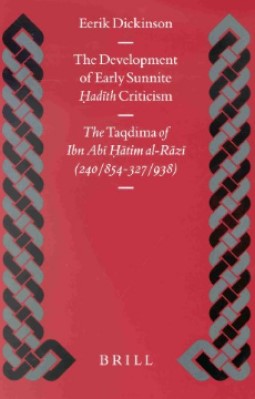The Development of Early Sunnite Hadith Criticism: The Taqdima of Ibn Abi Hatim Al-Razi (240 854-327 938)

| The Development Of Early Sunnite Hadith Criticism |
| Eerik Dickinson |
| 157 |
| |
| PDF Direct Link |
| Click for Copy from Amazon |
THE DEVELOPMENT OF EARLY SUNNITE HADITH CRITICISM – Book Sample
About the Book – THE DEVELOPMENT OF EARLY SUNNITE HADITH CRITICISM
“Hadith” are the documents recording the words and actions of the Prophet Muhammad. Originally an enormous and amorphous corpus, Muslim scholars of the third/ninth century separated the “hadith” they regarded as true from those they held to be forgeries, producing collection of “hadith” which still command the respect of Muslims today.
Ibn Abi hatim al-Razi (240/854-327/938) was one of the most prominent exponents and practitioners of “hadith” criticism. He left a copious written legacy, including his famous “Taqdima”, a biographical dictionary of the early “hadith” critics.
The “Taqdima” reveals Ibn Abi Hatims’s vision of the critic and gives insight into the mechanism of “hadith” criticism. It also provides a platform for the examination of the basic intellectual orientation of the “hadith” critics and their conflicts with their opponents.
THE TESTIMONIAL EVIDENCE
Having examined the basic format into which Ibn Abi Hatim cast the Taqdima, we are now prepared to look at the material he used to establish his genealogy of Hadith criticism.
As was noted above, the success of his enterprise hinges on his being able to make the case that certain prestigious personalities from the early history of Islam were critics of Hadith.
The material he cites consists entirely of transmitted reports, which, although extremely varied in nature, all share the characteristic of representing these individuals as critics. This chapter will examine some of the reports which may be described as testimonial in nature.
Ibn Abi Hatim’s main proof for the assertion that God has bestowed upon certain individuals the status of Hadith critic is the consensus of the learned within the Muslim community. 1
With this in mind, he supplies a great number of testimonials from various personages to the effect that the scholars treated in the Taqdima were critics of Hadith. Many of these testimonials take the form of straightforward declarations along the lines of “So and so was an authority in Hadith.” For instance, we read that Yahya b. Saed al-Qattan declared, “Malik was an imam İn Hadith.”2 They are usually placed at the beginning of each critic’s chapter under the heading “What is said about the knowledge and understanding of …..
Although most of those whose testimony lbn Abi Hatim records were traditionally recognized as “Hijazians,” in the introductory section of the Taqdima he alsa amasses evidence that some of the ahl al-ra) were in agreement with his proposition.
To read more about the The Development Of Early Sunnite Hadith Criticism book Click the download button below to get it for free
Report broken link
Support this Website
 Don't Miss out any Book Click Join OpenMaktaba Telegram group
Don't Miss out any Book Click Join OpenMaktaba Telegram group